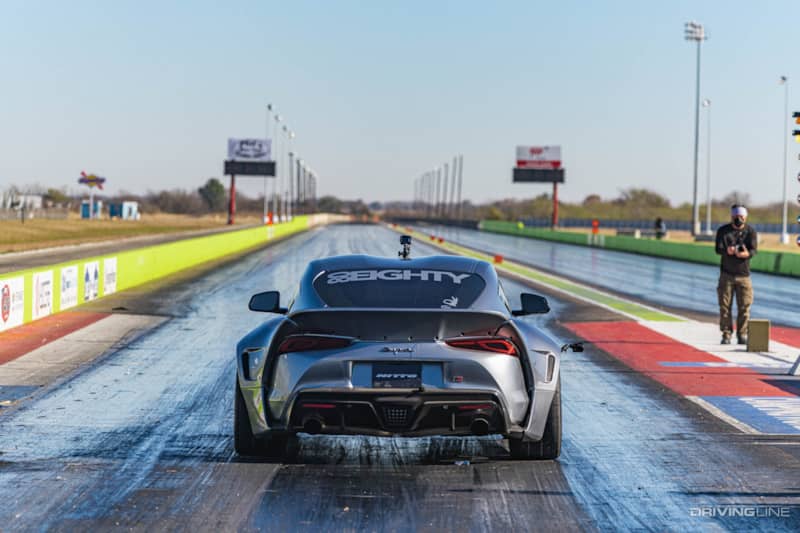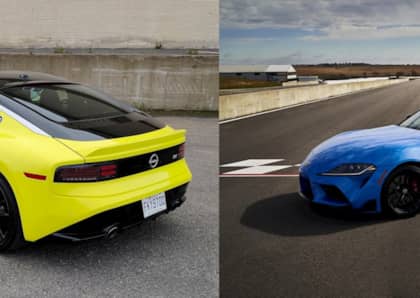Manual Transmission Monsters: The Toyota Supra Takes On The Nissan Z With A 6-Speed Of Its Own For 2023
Three years after the introduction of the latest-generation Toyota Supra, and a minor miracle has been visited upon its drivetrain. In a rare acknowledgement of a dwindling slice of the enthusiast crowd, the six-cylinder version of the car has gained a six-speed manual transmission.

The addition of a clutch pedal to the Supra formula makes it a more natural comparator to the already-six-speed Nissan Z, renewing a decades-old rivalry on more even terms. After spending time in both, it's clear that these coupes each provide their fans with a unique take on how a modern row-your-own sports car should feel.
A Tale Of Two Transmissions
A quick disclaimer about the Supra: its platform and power plant have been lifted wholesale from the BMW Z4, as both vehicles are built in a partnership between the two automakers. It might be surprising, given the brand's focus on producing high performance vehicles, but the Supra represents the only way BMW fans can get their hands on a version of the iconic B58 inline six-cylinder engine that's mated to a manual gearbox (a six-speed unit borrowed from ZF). As of 2023 even the M240i has lost access to anything other than an eight-speed automatic, restricting three-pedal action to full-on M cars like the M2, M3, and M4 (which are outfitted with the mightier S58 edition of the engine).

In practice, the shifter itself is completely fine. That may sound like faint praise, but there are plenty of manuals out there that subject drivers to vague, rubbery action as they move through the pattern, and that's not a problem with the Supra. At the same time, the satisfying mechanical movement found in some of the industry's best boxes—such as those fitted to Mazda's MX-5 Miata—isn't all that present either. This is a transmission that, once you've turned off the also-fine, but somewhat numbing automatic rev-match feature on downshifts, doesn't get in the way of enjoying the Toyota's impressive drivetrain, which is to be commended.

The Nissan Z offers a very similar setup, one that’s swift enough to be fun without inspiring any soliloquies about selecting this cog or that one. Auto rev matching is present and accounted for here, too, but again the most fun to be had is in turning it off and letting your feet do that special dance when swapping gears prior to corner entry. Keen sports car fans will no doubt notice the Nissan's somewhat shorter throws between gears as compared to the Toyota, and perhaps the extra exertion the Supra requires for its clutch kick, but it's not the kind of difference that stands out unless the vehicles are driven back-to-back, and certainly not a deal-breaker.
Real-World Driving
How does the Toyota Supra 3.0's twin-turbo I6 feel when slotted behind the new six-speed gearbox, versus its previous (and excellent) eight-speed automatic? The B58 is one of the best engines BMW has ever built, and there's no question that under the hood of the Supra it's making more than the 382 hp and 368 lb-ft of torque that represent its official rating.

This is a motor that pulls extremely hard above 2,000 rpm, which helps smooth out its occasionally lurching character in low-speed commuting. Throttle blips, especially with Sport mode engaged (via a single button on the center console), are eager and accounted for. The transmission gets better the more quickly the car is driven, tuning up the band with each successive run to redline.

Does the manual transmission dramatically affect the Toyota Supra 3.0's character from behind the wheel? It's no surprise that around-town driving is a little clunkier compared to the automatic, nor should it shock that the automatic is quicker with the foot to the floor (although only just). Where the clutch comes out ahead is in driver engagement. The automatic Supra has a grand touring feel, but with the six-speed installed it's that much more rewarding to explore the limits of the platform in the absence of the insulation provided by the ECU and torque converter working together. Toyota has made sure to help underscore this aspect of the six-speed experience by tailoring the car's stability control system to take into account more spirited driving (and reduce its occasional power-related over-rotation), and by installing a shorter rear gear ratio versus the automatic (to better deal with manual transmission's wider cog spread).

The Nissan Z's 3.0-liter twin-turbo six, which is deployed in a V-configuration, is also a sweetheart. Not quite as linear in its power delivery as that of the Supra, there are 400 horses and 350 lb-ft to play with. Unlike its Toyota rival those numbers feel accurate, and this is reflected in the fact that the Supra is actually significantly quicker in a straight line, even with the Z's launch control activated.

The Nissan gives up nearly a full second to the Toyota in a quarter mile drag race, and just over a half second when shooting to 60-mph, a surprise given that the Nissan's no-lift shift feature in theory allows for quicker gear changes.

Still, the Z is to be lauded for sticking more to the sports car formula than its competitor. Despite tipping the scales slightly heavier it feels like a more playful choice, albeit one whose antics can dip into the sliding scale with a ferocity that might intimidate some drivers. Not as poised as the Supra—the term 'raucous' comes to mind—the Z's chassis is better paired with the potential provided by a manual, versus the more predictable behavior of its available automatic.
Sticker Shock
The good news about the Toyota Supra 3.0 is that you don't have to pay extra for the manual transmission: adding the six-speed is a no-cost option.

The bad news? The six-cylinder turbo version of the Supra is considerably more expensive than its Nissan counterpart, checking in with an MSRP of just under $54,000 versus $41,000 for the Z. That's an enormous difference between the two vehicles, and even the cheapest Supra edition—fitted with a four-cylinder, and no manual on the menu—still costs thousands more than the Nissan (which maintains 400 horsepower for every model).

Even with the introduction of a manual gearbox, the fundamental split between the Supra and the Z remains the same. Nissan is courting sports car fans who want a reasonably affordable, tossable, and fun two-seat choice for weekend shenanigans. Toyota, on the other hand, has its sights—and profit margins—dialed in on a buttoned-down experience whose thrills arrive more quickly for those willing to make the extra investment.











